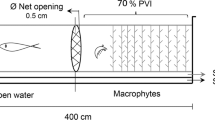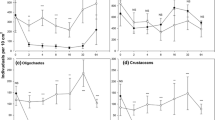Abstract
The impact of Pseudorasbora parva, a common zooplanktivorous fish species in Japan, on a zooplankton community was analyzed in experimental tanks, half of which were stocked with the fish. Different zooplankton species showed different responses to the introduction of the fish. In the presence of the fish, the populations of the large cladoceran Ceriodaphnia and the predatory copepod Mesocyclops were reduced, but the population of the herbivorous copepod Eodiaptomus and the small cladocerans Bosmina fatalis and Bosminopsis deitersi increased relative to the controls. The increase of Mesocyclops seen in the control tanks might have suppressed the populations of the small cladocerans, which are vulnerable to invertebrate predation. The results suggest that the population densities of the large prey items preferred by the fish, Ceriodaphnia and Mesocyclops, were controlled directly by fish predation, but the population densities of the smaller and less preferred zooplankton were controlled indirectly through the food-web cascade.
Similar content being viewed by others
Author information
Authors and Affiliations
Corresponding author
Rights and permissions
About this article
Cite this article
Chang, KH., Nagata, T. & Hanazato, T. Direct and indirect impacts of predation by fish on the zooplankton community: an experimental analysis using tanks. Limnology 5, 121–124 (2004). https://doi.org/10.1007/s10201-004-0116-7
Received:
Accepted:
Issue Date:
DOI: https://doi.org/10.1007/s10201-004-0116-7




